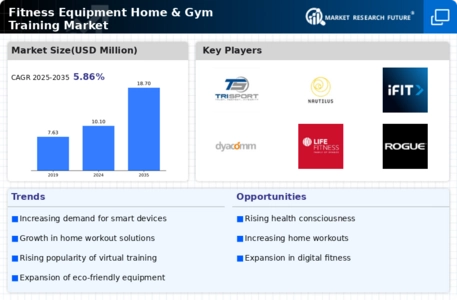Top Industry Leaders in the Fitness Equipment Home Gym Training Market
 The competitive landscape of the fitness equipment home and gym training market is marked by key players that play a pivotal role in the design, manufacturing, and distribution of fitness equipment. As of 2023, major companies influencing this market include Peloton Interactive, Inc., Icon Health & Fitness, Inc., Technogym S.p.A., Nautilus, Inc., and Johnson Health Tech Co., Ltd.
The competitive landscape of the fitness equipment home and gym training market is marked by key players that play a pivotal role in the design, manufacturing, and distribution of fitness equipment. As of 2023, major companies influencing this market include Peloton Interactive, Inc., Icon Health & Fitness, Inc., Technogym S.p.A., Nautilus, Inc., and Johnson Health Tech Co., Ltd.
Key Players:
Johnson Health Tech Co., Ltd.
Technogym S.p.A.
Trisport AG
Nautilus, Inc.
Echelon Fitness Multimedia LLC.
Peloton Interactive, Inc.
iFit Inc.
Dyaco
Anta Sports Products Limited
Life Fitness
Rogue Fitness (Coulter Ventures, LLC)
Accel Group (Tuntri New Fitness B.V.
Strategies Adopted:
The fitness equipment home and gym training market revolve around technological innovation, subscription-based models, strategic partnerships, and global market expansion. Technological innovation is a key driver, with companies investing in smart features, connectivity, and interactive content to enhance user experience and differentiate their products. Subscription-based models, offering content like live or on-demand fitness classes, have become integral to the business strategy of many players, creating recurring revenue streams and enhancing customer engagement. Strategic partnerships with fitness influencers, content creators, and media platforms contribute to marketing efforts and broaden the reach of fitness equipment. Global market expansion involves entering new geographic markets, adapting products to regional preferences, and forming strategic alliances to address the increasing global demand for fitness solutions.
Market Share Analysis:
The fitness equipment home and gym training market include brand reputation, product diversity, pricing strategies, distribution networks, and customer loyalty. Brand reputation is crucial for consumers seeking reliable and high-quality fitness equipment, with well-established brands often enjoying a competitive edge. Product diversity, offering a wide range of equipment types and models, allows companies to cater to diverse consumer preferences and needs. Pricing strategies, whether positioned as premium or budget-friendly, impact market share by appealing to specific consumer segments. Efficient distribution networks, including partnerships with retailers and online platforms, contribute to market reach and availability. Building and maintaining customer loyalty through effective marketing, customer support, and post-purchase services are essential for securing and expanding market share.
News & Emerging Companies:
The fitness equipment home and gym training market has witnessed the emergence of new companies and trends responding to the growing demand for home fitness solutions. Emerging companies often focus on niche segments, such as compact or specialized equipment, to differentiate themselves in the competitive landscape. Additionally, advancements in augmented reality (AR) and virtual reality (VR) technologies have gained traction among emerging players seeking to elevate the immersive experience of home workouts.
Industry Trends:
Industry trends in the fitness equipment market highlight a continued focus on digital fitness content, sustainability, and innovations in equipment design. Many companies are investing in creating or acquiring digital fitness content to complement their equipment, offering a holistic fitness experience to consumers. Sustainability initiatives involve using eco-friendly materials, reducing carbon footprints, and exploring recycling programs to align with the increasing consumer preference for sustainable products. Innovations in equipment design include space-saving solutions, modular designs, and multifunctional features to cater to the evolving needs of consumers.
Competitive Scenario:
The fitness equipment home and gym training market remains dynamic, with established players adapting to changing consumer preferences and emerging companies contributing to innovation. Market dynamics are influenced by factors such as the rise of home fitness trends, advancements in technology, and the impact of the COVID-19 pandemic on fitness habits. The resilience of the market is evident in its ability to cater to the diverse needs of consumers, from home workouts to professional gym setups.
Recent Development
The fitness equipment home and gym training market present a competitive landscape shaped by key players employing diverse strategies to meet the evolving demands of consumers. The emphasis on technological innovation, subscription models, sustainability, and global market expansion underscores the industry's commitment to addressing changing fitness dynamics. As the market continues to evolve, companies that can balance innovation with affordability and adaptability are likely to maintain a competitive edge in the dynamic landscape of the fitness equipment market.










